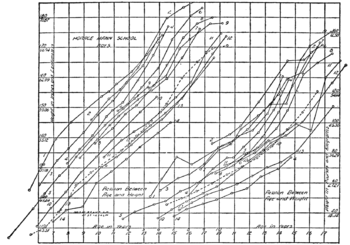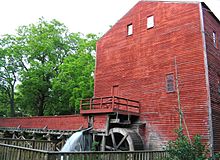성장 곡선(통계량)
Growth curve (statistics)통계량의 성장 곡선 모형은 GMANOVA(일반화 다변량 분석-분산)[1]라고도 하는 특정 다변량 선형 모형입니다.정의에서 보듯이 사후 매트릭스를 허용함으로써 MANOVA를 일반화한다.
정의.
성장 곡선 모델:[2]X를 관측치에 대응하는 p×n 랜덤 행렬, A를 q p p의 설계 행렬, B를 q×k 파라미터 행렬, C a k×n을 랭크(C) + p matrix n의 개별 설계 행렬, δ를 양의 정의 p×p 행렬로 한다.그리고나서
는 성장곡선 모델을 정의합니다.여기서 A와 C는 알려져 있고 B와 δ는 알려져 있지 않으며 E는 N(0,Ip,)n으로p,n 분포된 랜덤 매트릭스입니다.
이는 "포스트 매트릭스"[3]인 C를 추가하는 점에서 표준 다변량 분산 분석과 다르다.
역사
많은 작가들이 성장 곡선 분석을 고려했는데, 그 중 Wishart(1938),[4] Box(1950), Rao(1958)[6]가 그것이다.1964년 [3]포토프와 로이는 GMANOVA 모델을 적용한 세로 데이터를 최초로 분석했다.
적용들
GMANOVA는 조사, 임상 시험 및 농업 데이터의 [7]분석뿐만 아니라 최근에는 레이더 적응 검출의 [8][9]맥락에서 자주 사용된다.
기타 용도
수학 통계학에서, 생물학에서 사용되는 것과 같은 성장 곡선은 종종 연속 확률 과정, 예를 들어 확률 미분 [10]방정식을 거의 확실하게 푸는 표본 경로로 모델링된다.성장곡선은 시장전개 [11]예측에도 적용됐다.오차로 변수를 측정하는 경우 잠재 성장 모형 SEM을 사용할 수 있습니다.
각주
- ^ Kim, Kevin; Timm, Neil (2007). ""Restricted MGLM and growth curve model" (Chapter 7)". Univariate and multivariate general linear models: Theory and applications with SAS (with 1 CD-ROM for Windows and UNIX). Statistics: Textbooks and Monographs (Second ed.). Boca Raton, Florida: Chapman & Hall/CRC. ISBN 978-1-58488-634-1.
- ^ Kollo, Tõnu; von Rosen, Dietrich (2005). ""Multivariate linear models" (chapter 4), especially "The Growth curve model and extensions" (Chapter 4.1)". Advanced multivariate statistics with matrices. Mathematics and its applications. Vol. 579. Dordrecht: Springer. ISBN 978-1-4020-3418-3.
- ^ a b R.F. 포토프와 S.N. 로이, "특히 성장 곡선 문제에 유용한 일반화 다변량 분산 분석 모델", Biometrika, vol. 51, 페이지 313–326, 1964
- ^ Wishart, John (1938). "Growth rate determinations in nutrition studies with the bacon pig, and their analysis". Biometrika. 30 (1–2): 16–28. doi:10.1093/biomet/30.1-2.16.
- ^ Box, G.E.P. (1950). "Problems in the analysis of growth and wear curves". Biometrics. 6 (4): 362–89. doi:10.2307/3001781. JSTOR 3001781.
- ^ Radhakrishna, Rao (1958). "Some statistical methods for comparison of growth curves". Biometrics. 14 (1): 1–17. doi:10.2307/2527726. JSTOR 2527726.
- ^ Pan, Jian-Xin; Fang, Kai-Tai (2002). Growth curve models and statistical diagnostics. Springer Series in Statistics. New York: Springer-Verlag. ISBN 0-387-95053-2.
- ^ Ciuonzo, D.; De Maio, A.; Orlando, D. (2016). "A Unifying Framework for Adaptive Radar Detection in Homogeneous plus Structured Interference-Part I: On the Maximal Invariant Statistic". IEEE Transactions on Signal Processing. PP (99): 2894–2906. arXiv:1507.05263. Bibcode:2016ITSP...64.2894C. doi:10.1109/TSP.2016.2519003. S2CID 5473094.
- ^ Ciuonzo, D.; De Maio, A.; Orlando, D. (2016). "A Unifying Framework for Adaptive Radar Detection in Homogeneous plus Structured Interference-Part II: Detectors Design". IEEE Transactions on Signal Processing. PP (99): 2907–2919. arXiv:1507.05266. Bibcode:2016ITSP...64.2907C. doi:10.1109/TSP.2016.2519005. S2CID 12069007.
- ^ Seber, G. A. F.; Wild, C. J. (1989). ""Growth models (Chapter 7)"". Nonlinear regression. Wiley Series in Probability and Mathematical Statistics: Probability and Mathematical Statistics. New York: John Wiley & Sons, Inc. pp. 325–367. ISBN 0-471-61760-1.
- ^ Meade, Nigel (1984). "The use of growth curves in forecasting market development—a review and appraisal". Journal of Forecasting. 3 (4): 429–451. doi:10.1002/for.3980030406.
레퍼런스
- Davidian, Marie; David M. Giltinan (1995). Nonlinear Models for Repeated Measurement Data. Chapman & Hall/CRC Monographs on Statistics & Applied Probability. ISBN 978-0-412-98341-2.
- Kshirsagar, Anant M.; Smith, William Boyce (1995). Growth curves. Statistics: Textbooks and Monographs. Vol. 145. New York: Marcel Dekker, Inc. ISBN 0-8247-9341-2.
- Pan, Jianxin; Fang, Kaitai (2007). Growth curve models and statistical diagnostics. Mathematical Monograph Series. Vol. 8. Beijing: Science Press. ISBN 9780387950532.
- Timm, Neil H. (2002). ""The general MANOVA model (GMANOVA)" (Chapter 3.6.d)". Applied multivariate analysis. Springer Texts in Statistics. New York: Springer-Verlag. ISBN 0-387-95347-7.
- Vonesh, Edward F.; Chinchilli, Vernon G. (1997). Linear and Nonlinear Models for the Analysis of Repeated Measurements. London: Chapman and Hall.




